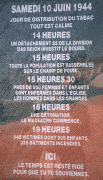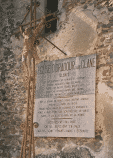| Sunday, 6th July 1997 - dimanche, le sixiéme juillet
|
I'd planned to be here [Limoges] last night in order to visit
something that I'd never heard of until it was mentioned in
rec.travel.europe.
Perhaps with good reason - the «Village Martyr» is
not the sort of tourist attraction that would be heavily publicised
internationally, especially to France's new dominant ally in the EC,
although arguably far more significant and far more important than any
of the better-known ones.
|
|
«Oradour-sur-Glane est le symbole des malheurs de la Patrie.
Il convient d'en conserver le souvenir, car il ne faut jamais
qu'un pareil malheur se reproduise.»
- Charles de Gaulle
|
|
 Plaque showing the events of the day.
Plaque showing the events of the day.
(96K JPEG)
|
|
Oradour-sur-Glane, about twenty kilometres away to the
north-west of the city, had originally been a typical sleepy country
village alongside the Glane river. But on the
10th June 1944, in retribution for various acts of
sabotage carried out by the Resistance, an SS company encircled the
village and assembled all of the population, including some visitors,
for what at first appeared to be a routine identity check. But, once
it had been ensured that everyone was accounted for and that there
would be no witnesses of what was going to happen, all of the
villagers were separated and locked away: the women and children in
the small stone church, the men in various barns and garages
throughout the village. In the inevitable conclusion, after what must
have been an agonising wait, the assembled villagers were massacred by
guns and grenades before their buildings were set on fire. After
most - but not all - had been killed, the Germans proceeded
to demolish every building in the village, including those in which
some of the victims still remained alive, by explosives and heavy
gunfire.
|
|
One can only assume that the object of the operation was «pour
encourager les autres» (or more appropriately
«discourager»), as the then German leader's inspiration
would have quoted. But if that were the intention, then why kill
everybody? - surely it would have been better to make an example of
some and leave the remainder to spread the word. Whatever the plans,
some of the villagers did indeed manage to escape, five men from one
of the barns and one lone woman from the church, to witness what had
happened. By nightfall that day, after the SS had departed, the
entire village was in ruins and all the remaining population -
197 men, 240 women and 205 children -
lay dead, still locked inside their barns and the church.
|
|

Memorial outside the church, where the women and children
were imprisoned. See below for a transcript.
(130K JPEG)
|
|
After the war, General de Gaulle declared the village a national
monument, to be maintained indefinitely both as a memorial to those
who had died and as a reminder to others. And so it is still in this
state today, enclosed by a high stone wall and with a new village
having been constructed a short way to the west. Apart from a few
people at each gate, there are no guides or officials here; visitors
are left to wander around and form their own conclusions. The only
instructions are not to enter the buildings and to maintain a
dignified silence: a very reasonable request, although some of the
more inconsiderate visitors seemed to be oblivious to that.
|
|

Panoramic view of the village green.
The small "building" to the right is one of their two wells («puits»),
protected by a roof and with the winder and rope still in place.
(73K JPEG)
|
|
Today I entered the village through the eastern gate, and climbed up
the hill to the old market square alongside the church. And it was
indeed in much the same state as it had been after that fateful day
53 years ago, with most of the buildings in the typical
rendered brick to be found everywhere in this region, but almost all
of them roofless and still blackened by the fire. Some work has
obviously been done since then, making the still-standing walls safe
and clearing some of the rubble from the interiors, but all the
indications of a traditional village life still remained: scales and
trays in the butcher's shop, cars and carts in various states of
repair in the garages and yards, a weighbridge mechanism still
connected to its platform outside, and various bicycles and the
ubiquitous foot-operated sewing machine in almost every house. The
more unrecognisable buildings and shops were identified by a plaque,
but most of the others are still recognisable for what they once were.
|
|
The victims are buried in the cemetery to the north of the village:
the identifiable ones in family graves, and the others in a mass grave
beneath the black marble monument. Around this monument were listed
the names and ages of all the martyrs, in most cases entire families
from babies in arms to the oldest grandparents. In an underground
exhibition room nearby, some smaller artifacts found in the buildings
and on the bodies of the victims were preserved: crockery and
ornaments, bottles melted and distorted by the fires, watches all
stopped at nearly the same moment, identity papers and all of the
other small items that until then had just been a normal part of life.
|
|

View of the cemetery, with its family graves and vaults, and
the memorial tower behind.
(60K JPEG)
|

Buildings facing the village green; note the car to the right
and the tram wires (along the main street) visible above it.
(91K JPEG)
|
|
The biggest surprise here was the tramway running along the main
street, with its catenary wires still hanging from the posts: this was
obviously an important means of transport in those days, running from
Limoges through to Confolens, although nowadays it has
completely disappeared apart from the short stretch here. There was a
small station opposite the «Mairie», with the tracks and a
small goods siding still in place and still displaying the station
name on the shelter.
|
|
It was very moving to be here, even so long after the event: a
reminder of what could so easily have happened on the other side of
the Channel had it not been for our determined air forces and
distracting events elsewhere. Everyone who believes that a nation
should not have whatever armed forces and weapons are necessary to
defend itself against invasion, or who thinks of civilian resistance
as some gallant pursuit against an uncomfortable enemy who will soon
be driven out, should be made to visit here - this graphic
illustration of the consequences will hopefully dispel their romantic
but dangerous notions.
|
|
|
Should you wish to visit
Please do, and form your own conclusions.
Just do the world a favour: leave your *&^**$$* camcorder at home!
The village is situated about twenty kilometres to the north-west of
Limoges (approximately 45°57'N; 01°02'E), on the D9
road. It should be marked on any reasonable map.
During the tourist season it is open from about 09:00 through to early
evening, every day; I would recommend that you allow yourself at least
2 hours to visit. There is no admission charge, although there
is a stall selling (reasonably tasteful) guidebooks and postcards.
Other information and links
A web search will turn up many, but the best site that I have found
describing not only the events of the day at Oradour but also the
background and subsequent events is Michael Williams' excellent
www.oradour.info.
You may encounter or have read Robin Mackness's book
book "Oradour: Massacre and Aftermath";
my summary of it is here.
I make no comment on whether or not is an accurate account of the
events.
|
| The memorial outside the church reads:
Église d'Oradour-sur-Glane
Silence
Ici des centaines des femmes et d'enfants furent
massacres par les Nazis. Vous qui passez soyez recueillis. Vous qui
croyez faites une priére pur les victimes et leurs familles.
Sur le bourg en ruines seuls restent debout dehors le Christ en croix,
dedans Notre Dame de Lourdes et Bernadette.
«Venez a moi vous qui souffrez» dit le Christ,
«faites ce qu'il vous dira» dit la Vierge.
Requiescat-in-Pace
Qu'ils reposent en paix car ils sont vivants dans l'éternité
|
 Plaque showing the events of the day.
Plaque showing the events of the day.



